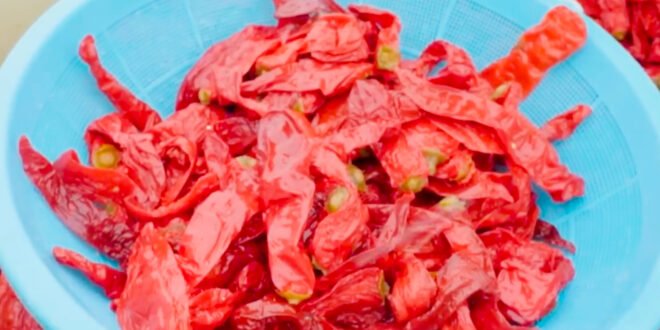Ever wondered why Japanese Kanzuri Chile Paste is so expensive? Find out in this video, where we explore the history and production of this unique ingredient in Japanese cuisine. Discover the secrets behind its flavor and why it’s a must-try for any food enthusiast or traveler in Japan.
This isolated patch of snow-covered Japan has four tidy rows of red dots dividing it. If you enlarge, you’ll realize that they are, in fact, chili peppers. This is the whitening of snow. It plays a big part in the distinct flavor of kanzuri chili paste. This small bottle, which took six years to develop, retails for about $20, a significant amount more than the $3 price of mass-produced chili pastes that are seven times smaller. However, a dilemma is about to arise.
The only firm making the paste says it can’t and won’t skip this stage, putting the future of kanzuri in peril because warmer winters have made it tougher to get enough snow. Do these peppers taste any different after bleaching in the snow? And is the scarcity of snow a factor in the price of kanzuri chili paste? The producer says that snow whitening mostly attributes to the flavor. Atsushi buys kanzuri from the only company in the world that produces it, the Kanzuri Company, which is based in Myoko, in the Niigata Prefecture of Japan.
That is the origin of kanzuri. Akihito is prepared to go to considerable measures in order to achieve snow whitening, as it is essential to the final taste and quality. The team starts working as soon as they get to the ski resort.
This is the closest location with at least 50 centimeters of snow accumulation that Akihito could locate. To compact the snow, they must first tread on it, but the snow can only be 20 centimeters thin. This deep snow is quite necessary.
The packed snow will keep the chili peppers from blending in with the surrounding soil in the event that the weather warms up before they are ready. If not, they will become polluted and useless. This net ensures that we collect every pepper and enhances the separation when we gather them three or four days later.
The group is bleaching over 300 kg of chili peppers today. They kept the chili peppers in salt pickles from summer to winter. Only during the winter months, almost ten times a year, do workers snowplow the peppers.
As a result, production is further limited, and the finished bottle of kanzuri costs more than chili pastes that are mass-produced. And it takes years to produce the paste itself. Sato Kazushige is processing today’s harvest to make a fresh batch at Kanzuri’s facility.
Four basic ingredients are used to make kanzuri paste. Rice Goji, yuzu, snow-bleached chile peppers, and salt. Initially, we mix rice Goji, which the fungus has colonized and typically ferments for two days, with the bleached peppers.
The freshly prepared yuzu paste is the other essential component. After combining all the components, Kazushige keeps this freshly made kanzuri in the storeroom. There are 600 tubs there, each holding 350 kg of paste, waiting to mature.
The most costly kanzuri requires an aging period of six years, or at least three years. Conversely, a lot of simpler chili pastes just ferment for a week or two. A tiny bottle of three-year-aged kanzuri paste costs $6 locally.
Paste aged for six years costs $9. And the price is more than twice as much when exported.
The area in which the kanzuri is kept can also influence how well the fermentation proceeds. Kazushige compares the color to this chart in order to maintain equilibrium among all these factors and ensure the caliber of the finished bottle. The kanzuri is ready to be sold if it falls between these six shades.
With the exception of a little automation, this procedure follows the traditional guidelines for creating kanzuri. Each household created kanzuri in its own unique style prior to Tojo Kuniji, Akihito’s grandfather, founding Kanzuri Company. Furthermore, the originally modest Miyoko Household Condiment is now well-known throughout the world.
However, the current challenge of locating a sufficiently deep frozen plain will probably still affect the kanzuri producers of the future. Niigata Prefecture received only 25 centimeters of snow in January and February 2024, compared to 93 centimeters in 2023. There was very little snowfall in 2020, and throughout the previous 70 years, snowfall has generally decreased.
Because of this variation, Akihito cannot depend on there being enough snow to bleach the peppers. Producers of the priciest foods in the world struggle to find dependable land. Locals in Colombia who make indigenous panela, extremely expensive raw sugar, have had to relocate to ever-higher elevations in order to produce it, which requires them to trek farther to sell it.
Due to droughts, Kashmir’s crops are producing much less saffron, which is the most costly spice available. Some producers are obliged to sell their land since there are fewer suitable fields. Warmer waters in Spain are forcing baby eel fishermen to move shores more often in an effort to acquire enough fish for a market. I mean, this isn’t going well at all. Hey, it’s almost that time. We are switching beaches.
Similarly, in Niigata, Akihito will need to keep looking for the ideal spot, increasing the expense of manufacturing and, ultimately, the price of the kanzuri bottle. But he’s not giving up on snow bleaching; without it, a Niigata kanzuri wouldn’t be the same. Especially considering that in the past 20 years, the paste’s demand has increased by 20%.
A sufficient amount of snow is the first issue. Having enough peppers is another. The indigenous togarashi pepper is used to make kanzuri.
It’s now down to four or five, according to Akihito. He adds that the business might soon need to cultivate all of its own peppers.
Even if they are less expensive, Akihito says importing them is out of the question since, without these togarashi peppers, kanzuri wouldn’t taste the same. It is so touching that people travel from all over the world to this location to purchase kanzuri. It makes me feel proud.
It provides support for our efforts. The ability to express themselves verbally touches the Niigata people as well. We take pride in the kanzuri produced in Niigata.
 DailyDiscovery
DailyDiscovery




